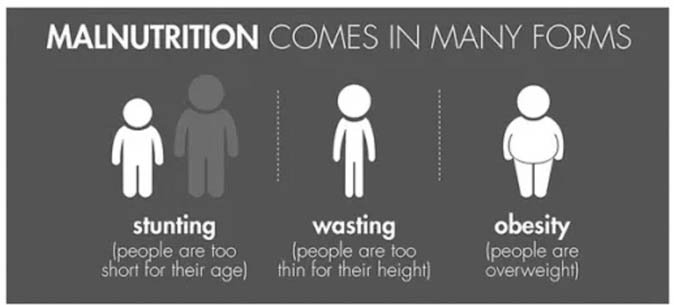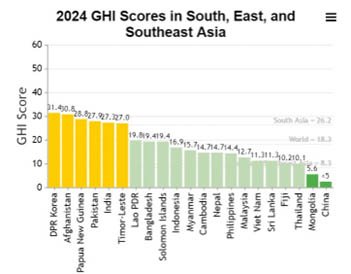GLOBAL HUNGER INDEX, 2024
The Global Hunger Index (GHI) is a multidimensional tool used to track hunger levels worldwide. It provides a comprehensive picture of global hunger, enabling stakeholders to understand the challenges and progress in food security.
India’s Ranking: 107 out of 127 countries, with a score of 27.3, indicating a serious level of hunger.
 ABOUT THE INDEX
ABOUT THE INDEX
The Global Hunger Index (GHI) is a tool designed to comprehensively measure and track hunger at the global, regional, and country levels.
- High-income countries are not included in the GHI.
- The GHI has been released by Welthungerhilfe (lately in partnerships with Concern Worldwide) since 2000.
- The GHI ranks countries on a 100-point scale, with 0 being the best score (no hunger) and 100 being the worst, although neither of these extremes is reached in actuality.
- GHI scores are evaluated on four parameters divided in 3 broad categories.
- Undernourishment
- Child Stunting
- Child Wasting
- Child Mortality


 KEY HIGHLIGHTS
KEY HIGHLIGHTS
 GLOBAL INSIGHTS
Global GHI Score
GLOBAL INSIGHTS
Global GHI Score

- The world's overall GHI score is 18.3, categorized as moderate hunger, showing a slight decrease from 18.8 in 2016.
Countries in Crisis
- 22 countries have seen an increase in hunger since 2016.
- 20 countries have experienced stagnation in progress.
- Five countries (Fiji, Jordan, Libya, Syria, and Venezuela) have faced worsening hunger conditions since 2000.
 REGIONAL ANALYSIS
REGIONAL ANALYSIS
- Africa South of the Sahara
- Highest Hunger Levels: Most concerning hunger status globally.
- GHI Score Improvement: Significant over the last 20 years, but virtually stalled since 2016.
- Child Mortality Rates: Highest in the world.
- Climate Change Impact: Reduced agricultural productivity growth by 34% since 1961.
- South Asia
- Serious Hunger: High levels of undernourishment and child undernutrition.
- Undernourished Population: 281 million, accounting for nearly 40% of global undernourishment.
- Key issues in Afghanistan, India, and Pakistan, with progress noted in Nepal reducing child stunting.
- West Asia and North Africa
- Stagnant GHI Scores: Moderate category affected by conflict and climate change.
- Yemen: Long-term hunger crisis; Syria has seen significant score increases since 2000.
- Latin America and the Caribbean
- Hunger Status: Low, but the only region where hunger has worsened since 2016.
- Haiti: Rapidly increasing hunger levels due to multiple compounding crises.
- East and Southeast Asia
- Low Hunger Levels: Progress has stagnated; significant disparities exist among countries.
- Serious hunger in DPR Korea, Papua New Guinea, and Timor-Leste.
- Europe and Central Asia
- On Track for Low Hunger by 2030: Improvements in agricultural productivity and economic growth.
- Turkmenistan and Tajikistan: Highest GHI scores in the region, though Tajikistan has shown notable progress.
INDIA’S STATUS
GHI Score and Ranking
- India’s GHI score of 3 places it in the "serious" hunger category.
- The country has seen a decline in rank from 111th in 2023 to 105th in 2024.


 GHI SCORE TREND FOR INDIA
GHI SCORE TREND FOR INDIA

- India’s GHI score has fallen since 2000, however, child wasting and stunting remain very high.
- The GHI raises concerns, with recent data indicating that 3.2% of the Indian population does not meet minimum meal requirements.
India’s previous ranking: 101/116 countries.(2021) ;107/121 countries (2022); 111/125 countries (2023)
UNDERNOURISHMENT STATISTICS FOR INDIA
 THE CURRENT GLOBAL FOOD CRISIS
THE CURRENT GLOBAL FOOD CRISIS
- Extreme Hunger: 350 million people are currently experiencing extreme hunger conditions.
- Famine Risk: 49 million individuals are at the brink of famine.
- Chronic Undernourishment: Over 820 million people are suffering from chronic undernourishment.
- Malnutrition and Gender Disparities: 60% of those affected by malnutrition-related causes are women.
- Child Mortality: Approximately 5 million children under five die daily due to malnutrition-related causes.
CONTRIBUTING FACTORS
Several interlinked issues contribute to the current food crisis:
- COVID-19 Pandemic: The pandemic disrupted supply chains and food access.
- Geopolitical Conflicts: Ongoing conflicts exacerbate instability and food insecurity, particularly in regions like Ukraine and the Middle East.
- Economic Downturns: Inflation and rising food and fuel prices contribute to increased hunger levels.
- Climate Crisis: Erratic weather patterns, droughts, and floods impact agricultural productivity.
KEY ISSUES WITH GHI
Methodological Critiques
- Child-Centric Indicators: Three out of four indicators focus on children, which may not represent the hunger situation of the entire population.
- Stunting as an Indicator: Critics argue that stunting can occur in well-nourished populations and may not accurately reflect undernutrition.
- Outdated Data Sets: Some data sources, like National Family Health Surveys, lack timely updates, leading to potential inaccuracies.
Note: Connect with Vajirao & Reddy Institute to keep yourself updated with latest UPSC Current Affairs in English.
Note: We upload Current Affairs Except Sunday.